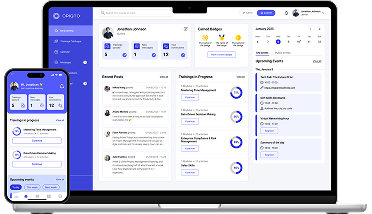As of 2023, 94% of enterprises use the cloud, with 67% of enterprise infrastructure being cloud-based. The trend accelerated in 2020 by the pandemic and the sudden need for remote work solutions affects e-learning and L&D no less than any other line of company operations. And there are good reasons for that which we will cover in this article. But first, let's figure out what cloud-based software is and what e-learning solutions it offers.

Cloud software is software hosted remotely that one accesses via the internet, like email, iTunes, Google Drive, or AWS. Learning management systems can also be cloud-based, but this wasn't always the case.
At the dawn of e-learning, LMS solutions developed in-house or purchased were installed on everyone's PC, e.g., from a CD, and there was no way to update the platform or the content without another CD with a newer version, so imagine the headache organizations went through each time they needed to distribute an update. And don't get us started on device compatibility. While revolutionary in their time, these on-premises solutions hindered agility and scalability.
As technology advanced and internet usage grew, the era of web-based LMS platforms, like Opigno, started. This shift offered greater accessibility and flexibility, allowing an organization to host the learning platform that learners would access through web browsers on its servers. It was, essentially, a cloud-based service for the learners but not for the training provider yet. Nearly 87% of active users have web-based LMS programs now.
Today, the companies providing cloud infrastructure and applications have massively grown, and it has also revolutionized how we perceive and engage with learning management. A new breed of solutions emerged: cloud LMS — a cloud-based solution that provides software access, usually on a subscription basis as Software as a Service (SaaS). Now, not only can the learners access an LMS via the internet, but an organization doesn't need to host and maintain it and rents the ready-made platform from a vendor.
The advantages of cloud LMSs
Such a model provides many perks compared to self-hosted options. Here are the most prominent ones.
Accessible anywhere, anytime, and from any device
As users don't need to install any software, only internet access is necessary. It doesn't even have to be constant — platforms using xAPI standard support offline access and update users' progress once the connection is restored.
Additionally, since cloud LMSs are available on any device, they are usually designed to fit any device. This is especially important since at least a quarter of employees access training from mobile devices, while learners using smartphones for learning in general complete courses 45% faster than those using a computer.

Easy to set up, upgrade, and manage
A cloud LMS is already fully developed and deployed on the vendor's servers. A couple of integrations with the learner base and content library, and the platform is ready to roll out. If the organization doesn't require any other complex integrations and customizations, it can launch the LMS the same day; all left is to onboard the learners and administrators.
The technical side of the question — maintaining and expanding the infrastructure, resolving technical issues, patching, updating, and upgrading the hardware and software — is the responsibility of the vendor's dedicated team. The vendor is in charge of keeping the platform up and running at all times, so they invest in their assets heavily and make all the patches and updates instantly accessible for all users.
Overall, the evolving demand facilitates constant product development and improvement to meet the industry's needs and stay competitive. Plus, you get your platform developed and managed by talent you probably wouldn't access so easily otherwise but at a fraction of the cost.
Scalable and cost-efficient pricing
Speaking of costs, opting for a cloud LMS means no development, license, and setup costs, while not having to maintain, upgrade, and fix an LMS on your own can significantly reduce ongoing and remove unforeseen expenses. Everything is covered by regular subscription fees, usually monthly or annual, that are much more convenient to factor into a budget.
The pricing is usually based on usage — number of users, tenancies, features, or amount of data — and can be easily scaled up and down so that the client pays only for what they truly need.
Flexibility and scalability
Flexible pricing reflects the flexible nature of SaaS solutions in general. An organization can quickly adapt an LMS to its needs: change the number of users, opt in or out certain functionalities, add as many learning materials as needed by simply choosing a fitting tariff plan, with no burden of upgrading the infrastructure. As your training needs transform, your SaaS LMS can transform, too.
Besides being scalable and configurable, cloud-based LMSs are also multi-tenant by definition, enabling organizations to create separate spaces for different objectives managed and updated simultaneously and accessible for the learners 24/7.
Security
Cloud-based software must meet higher security and data privacy standards and receive third-party certifications as the clients entrust it with their data, e.g., GDPR, Service Organization Control (SOC) 2, or IS0 27001. As a result, the vendors invest a lot of time and money into making security and reliability their strongest qualities (apart from convenience).
Similarly important are data backups. Backups are integral to cybersecurity as they allow quick restoration of operations in case of an attack or any other disruption. And given the data volume and limited data storage capacity, it's easier to set regular automated backups in the cloud rather than handling everything in-house.
Another less evident advantage to remote data storing is that the cloud vendors can tend to hardware much better, preventing data losses due to failing equipment.
Seamless integrations
LMSs may not cover all the needs of end-users or organizations. Integrations with third-party software and different internal systems can compensate for that. Cloud LMSs usually provide APIs that allow easy integration with other systems, such as CRM, billing software, and subscription tools. Custom integrations may require negotiations with the service provider and additional fees.
With the right integrations, cloud LMS software can seamlessly fit into an organization's tech stack, making it more efficient, e.g., automate tasks like user creation, data synchronization, and enrollments or connect training results from the LMS to other software to streamline systems and reduce technical complexity.
User-friendly UI and small learning curve
Cloud-based LMSs are supposed to eliminate the need for dedicated IT personnel or access to an IT department. As a result, they are designed to be user-friendly to allow beginners to quickly adapt to the functionality and start the learning process without any hassle. Moreover, the constant support from the LMS vendor ensures that any queries or issues are promptly addressed, providing a smooth user experience.
One of the key advantages of cloud LMS systems is that they enable end-users to focus on their learning content while the vendor takes care of the tech complexities. A robust SaaS LMS also offers high bandwidth for unlimited content uploads, enabling users to include high-quality graphics and videos.
A good SaaS LMS should also offer easily configurable and user-friendly features, allowing organizations to tailor the interface to their needs. Portals and unique training environments enable catering to specific learner groups, while features like automation and reports help reduce administrative workload.
In summary, cloud-based LMS systems excel in ease of learning, offering user-friendly interfaces, constant support, and features that empower end-users. These systems simplify learning and learning management and ensure compliance, security, and high-quality content.
The limitations of cloud LMSs
Cloud is not a silver bullet, and cloud-based LMSs have their share of downsides, too. Here are a few reasons why self-hosting an LMS might be a better solution for some.
No control over the platform
An organization doesn't own but rents its cloud LMS instance and can use it only while it pays a subscription. The client also cannot freely modify cloud LMS's source code as it could modify a self-hosted solution. It all limits the readily available use cases to those provided by the vendor design.
The client also has little say in the product development direction. The vendor can change the pricing policy, retire features that it doesn't deem relevant to the market anymore but that are still relevant to this client, add new default features the client doesn't need, or overhaul the interface — the client can only adjust to the changes or change the vendor.
Finally, by relying on a third-party vendor, there's no guarantee that they won't go out of business or stop developing the product.
Limited customization
This point stems from the previous one — as you don't own a SaaS LMS, you can't change it however you want besides the branding. The vendors usually provide several pre-made configuration options you can choose from or offers to pick the features, functionalities, and integrations from a list. In other words, average cloud-based LMSs are rather configurable than customizable, so if an organization requires a heavily customized solution or integration with specific software used internally, an on-premises LMS might be better.
However, some vendors, like Opigno, offer custom development services for their cloud-based solutions, enabling customers to get a SaaS platform tailored to their needs.
Higher ongoing expenses and steep pricing increases
If the company has an in-house development team and doesn't plan to grow its training in the foreseeable future, it might be cheaper to invest in the on-premises infrastructure once than pay for a subscription each month. It's worth noting that, in this case, the company would have to bear all the emergency expenses if something goes wrong.
Another nuance to consider is the terms of tariff plans. Suppose the company does plan to scale its training up. In that case, it needs to ensure that a higher tariff plan would still be cost-effective, as most SaaS LMSs charge not for each additional user, tenant, or course but for a specific range of users, tenants, and courses, and training 55 learners can cost, let's say, 1.5 times more than 50 simply because 55 users fall into a higher tariff plan.
Security concerns
While cloud vendors adhere to high security standards, certain risks are connected with an organization surrendering control over its data to a third party. If it's principal for an organization to have full control over its data at all times, internal hosting is the way. Keep in mind, however, that control doesn't equal safety, and cloud vendors, as a rule, allocate far more resources and attention to data security than any company not specializing in cybersecurity ever could.
There are no universally wrong or right choices, and the advantages of cloud LMSs outweigh the downsides for most use cases. If you'd like expert advice on whether SaaS or on-premises LMS would benefit you best, don't hesitate to contact us — we develop both.

Choosing the best cloud LMS
Choosing the best-fitting cloud LMS differs little from choosing an LMS in general (which we've covered before). However, as cloud LMSs usually offer fixed functionalities, it's even more important to thoroughly analyze one's needs and check how well the solution can meet them.
Define your learning model
All LMSs are suitable for asynchronous learning. But if you plan to provide blended learning, you need to ensure the cloud LMS supports related technologies, e.g., Zoom integration for synchronous sessions or an internal video conferencing tool, a calendar with class schedules and assignments, etc.
Identify the must-have functionalities
For example, ensure that the LMS has content authoring features and supports all the multimedia and e-learning standards you plan to use if you create courses. Check what assessment and certification tools the platform offers if you plan to use it for compliance training. Or ensure the SaaS LMS vendor provides a native mobile app if you prioritize mobile learning.
Each feature the cloud LMS lacks means more hurdles with integrations and workarounds in the future.
Check available APIs and third-party connectors
Examine the list of available APIs to see if the LMS can integrate into your existing stack and processes. For instance, if you plan to use an LMS for onboarding, integrations with HR tools are non-negotiable. If you plan to sell courses, you might make use of marketing tools and sales and support software integrations. And Single Sign-On (SSO) would benefit any LMS out there.
Assess security and compliance
Ensure your LMS platform is transparent about meeting essential industry standards for security and compliance, undergoing regular external and internal audits, and its security policies.
Evaluate scalability and support
Consider your organization's growth potential. Ensure the platform can scale with your increasing needs in terms of users, content, and performance. Additionally, investigate the level of customer support and training the vendor provides. A responsive support team and comprehensive training resources can be invaluable in ensuring a smooth and productive experience for both administrators and learners.
By defining your learning model and essential functionalities, examining integrations and security, and considering scalability and support, you can find a well-suited cloud LMS that will empower your educational or corporate initiatives and contribute significantly to your success.
As we trace the evolution of learning management systems, it becomes evident that the cloud market will grow, bringing more dynamic, user-friendly, and scalable Software as a Service LMSs. The time is now for institutions and businesses to embrace the shift to unparalleled accessibility, robust security, and unmatched adaptability in the rapidly changing digital age cloud offers.
Take the next step in your learning and training journey by exploring our company's cutting-edge Opigno LMS and unlock the limitless possibilities that the cloud combined with open source can provide.
Published on October 17, 2023.
